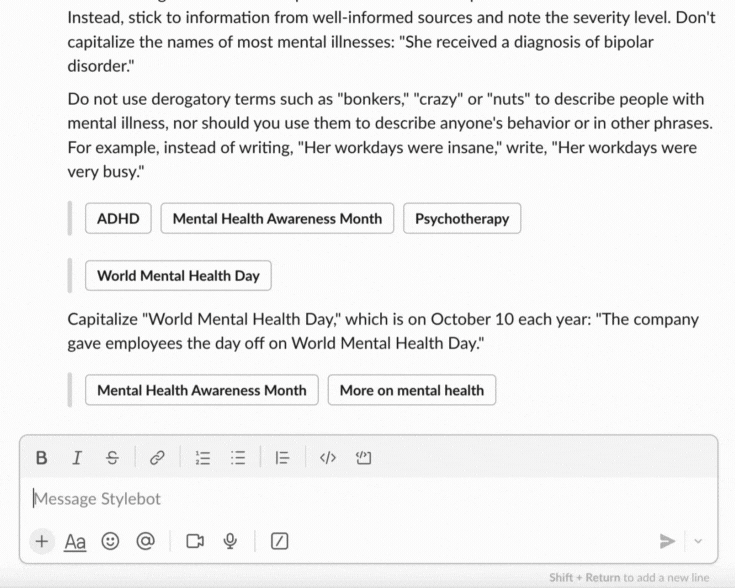“Where have you been all of my life?”: How Stylebot helped CalMatters create a custom, all-in-one style resource that saves time while improving quality
By combining Stylebot’s style guide with CalMatters’ database of California legislators, journalists can check everything from how to write about people experiencing homelessness to whether an assemblymember uses their full name or nickname.
Tl;dr
Company: CalMatters
Industry: Nonprofit news
Stylebot platform: Slack
Reason for use: Creating a customized style resource
Biggest benefit: Time saved while maintaining credibility
Does that legislator go by Phil or Phillip? Greg or Gregg?
Is there a hyphen in that senator’s last name?
And where is she based again?
With dozens of reporters covering California’s 120 state lawmakers, questions like these come up every day at CalMatters, a nonprofit, nonpartisan news organization that covers the government of the nation’s most populous state. Journalists at CalMatters shine light on state government, write detailed policy explainers, publish voter guides and explore solutions that affect the daily lives of Californians. Its award-winning journalism reaches 1 in 10 Californians through partnerships with 250 media organizations that use CalMatters’ content for free.
“We’re filling a void that exists,” Vicki Haddock, CalMatters’ managing editor, said. With many news organizations in recent years pulling back on state government coverage, many Californians “know more about what’s happening in Washington than what’s happening in Sacramento.”
One of the many services CalMatters provides to California residents and news organizations is Glass House, a publicly available online directory that provides easy-to-access details on each state legislator’s ideology, campaign contributions, special interest associations, biographical information, contact information and more. And to surface this information more readily, CalMatters automatically tags legislators’ names in stories with a link to their entry in the directory.

Spelling someone’s name correctly is a must for every journalist in every story, but if you’ve ever worked in a newsroom, you know that getting someone’s name right doesn’t always stop at spelling. In order to maintain consistency for readers, media organizations often determine a specific way to refer to a person who gets mentioned a lot: “President Joseph R. Biden” instead of “President Joe Biden,” for example. It’s not that hard to remember such rules for a few people, but it’s a different story when you’re dealing with 120 names, locations and each person’s political affiliation.
“There are enough variables in there that it’s pretty easy to become inconsistent and get something wrong,” Neil Chase, CalMatters’ CEO, said. And in CalMatters’ case, calling Eloise Gómez Reyes “Eloise Reyes” instead of using her full name, or using “David Min” instead of “Dave Min” has ripple effects. If the name isn’t formatted correctly in the story, it won’t alert the database, which not only won’t link to the lawmaker’s information in the story, but it will leave out details from the lawmaker’s profile.
“It could all go awry with the smallest hitch,” Haddock said.
That’s why CalMatters turned to Stylebot.
A specific need
Stylebot helps media professionals save time without sacrificing quality by answering writing and editing questions on Slack, Microsoft Teams and Google Chrome. It’s powered by a style guide that can answer thousands of writing questions ranging from, “Do I put a hyphen in full time?” to, “How can I ensure my writing is inclusive?” Stylebot can also be customized to fit an organization’s needs.
In CalMatters’ case, Chase wanted a faster and easier way for editors and reporters to verify each lawmaker’s name, party and district headquarters. With the newsroom already using Slack for its daily operations, having the information instantly accessible there was a natural fit.
So now, when CalMatters reporters write a story and need to know where Megan Dahle’s district office is currently located, they can just ask Stylebot on Slack.

“When I first learned about Stylebot, my first thought was, ‘What’s the catch? It can’t be that easy,’” Haddock, who oversees seven editors at CalMatters and has four decades of experience as a journalist, said.
Now, Haddock said she gets a similar reaction from new CalMatters staffers who use Stylebot for the first time.
“I hear from people who have a ‘where have you been all of my life?’ attitude,” she said.
By combining its legislator database with its in-house style guide and Stylebot’s style guide, CalMatters used Stylebot to create a new, all-in-one style resource that saves time while improving the organization’s accuracy and credibility. Reporters save time looking up style rules and editors spend less time fixing mistakes.
“Time is time. Whether you’re doing something as a breaking story, or you’re doing a long investigative feature, however much time you don’t have to spend looking something up is time you spend doing something more productive,” Haddock said.
Stylebot isn’t just designed for speed, though. In addition to allowing reporters to get their writing questions answered without opening another email, tab or document, Stylebot also makes the editing process more approachable. By using machine learning and natural language processing to match conversational questions with a human-written answer, Stylebot helps journalists navigate traditional style resources, giving them advice on everything from whether “homemade” is one or two words to incorporating ethical and inclusive language.

By allowing journalists to check the basics, get guidance on nuanced topics and have a little bit more fun in the process, Stylebot increases engagement with an organization’s foundational document.
“The only asset any news organization actually has is trust and credibility,” Chase said. “Little things like getting names right, getting terms right, these days is a huge credibility boost.”








